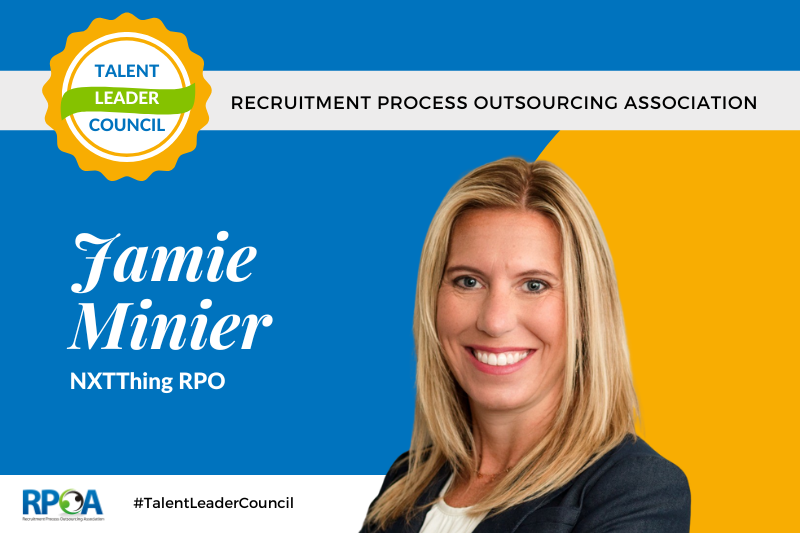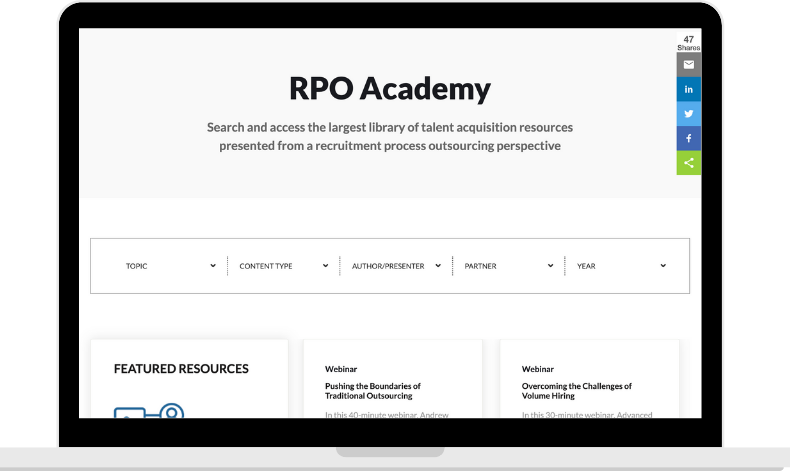
Talent acquisition leaders face a growing challenge in today's competitive talent market. Companies invest heavily in collecting recruitment data but often fail to act on their insights. According to talent leader council contributor Jenna Hinrichsen, "The biggest challenge is that companies don't necessarily embrace the data... it's one thing to say, I want to see the data and look at it and understand it and analyze the data, and it's another thing to actually make changes." This resistance to data-driven decision making creates significant consequences: extended vacancies, increased hiring costs, competitive disadvantage, and deteriorating candidate experience.
Recruitment Process Outsourcing (RPO) providers serve as strategic partners that help organizations bridge this gap between data collection and implementation. The 2025 RPO Trends Report provides help to overcome organizational resistance to acting on hiring data.
In this edited version of RPOA's interview with Jenna Hinrichsen, Director of Recruitment Strategy and Labor Market Analytics at Advanced RPO, she shares practical insights on implementing effective data-driven recruitment strategies. This post is part of the latest from the RPOA's Talent Leader Council.
RPOA: How can data help organizations move from reactive hiring to a more proactive workforce planning?
Hinrichsen: The key is really understanding the talent and competitor landscape around you. That means coming in and looking broadly at the market around you and knowing what you're up against. For example, is your pay competitive with the market and your talent competitors? If not, what can you do to offset that to attract talent?
When you're looking at hiring data, you've got to look at it from the perspective of talent competitors as well as industry competitors. If you're in the manufacturing or healthcare space, and you're hiring a production worker or an accountant, it doesn't mean that your only competitors are the ones in your industry. Any company in your area hiring for those skill sets is your talent competitor.
Being flexible is also important. Can you be flexible in skills and experience? If not, is there another location? Do you have other offices? Do you have the ability to allow workers to work from home? If the market that you sit in currently is too expensive to hire people, do you have the ability to hire people in different locations? From a workforce planning perspective, you'll want to know these things up front.,
Q: Can you give us some examples of data-driven insights that have significantly improved hiring outcomes?
Aligning your pay with the market and with your talent competitors is key. It's one of those things that companies just don't want to hear about. But, the reality is most people work for pay, and that's what's going to make the biggest impact.
If you can't be as competitive with your pay, where can you compromise? Just as I said in regards to workforce planning, flexibility becomes essential here, too. Can an individual work from home? Could offering remote work attract talent to locations where your salary is more competitive? Can you offer a sign-on bonus? Is there in-house training so you could look at a less skilled individual and provide internal training to get into that pay range that's more competitive?
It's not always black and white. You don't have to pay exactly what your competitors are paying, but you do have to look at it from different angles and see where you can be flexible – whether that's in work arrangements, compensation structure, or experience requirements.
Looking at years of experience is also important. Hiring managers often ask for someone with a specific number of years of experience without understanding what's available in their market. For example, if you're looking for an accountant with 10 years of experience and specific software knowledge, but the labor market data shows most available talent has zero to four years of experience, you have to align your expectations with market reality to make the right hire.
Q: What are the biggest challenges that you see companies face in implementing a data-driven talent acquisition approach?
The biggest challenge is that companies don't necessarily embrace the data. It's one thing to say, I want to see the data, and it's another thing to actually make changes. Making those changes is what moves the needle.
You can't just look at the data and say, 'Well, this is what our company offers.' You have to be able to make changes in certain areas. You don't have to change everything, but change what you can.
If you want to overcome these challenges, there are going to be moves that a company or hiring manager has to make to be competitive. Just having the data is not enough. It's really acting on the data that is the biggest challenge.
Being prepared to make changes means shifting from, this is how we do it at XYZ company, to how can we evolve as an employer and be competitive. To be competitive, you've got to look at where you can be flexible. There are going to be areas where you can't be flexible, and that's fine. But, knowing the spots where you can be flexible is really key.
Many times when companies ask for data, they want to see proof that the data confirms what they're already saying. If it doesn't say that, then it's easier to walk away from it. A lot of times they just don't want to hear the reality.
Q: Let's talk about best practices for organizations to integrate analytics effectively into their talent strategies.
The first one is data first before anything else. When you're kicking off a search, the very first thing you should be doing is understanding the market. What is happening in that market? What are the realistic expectations?
Before reaching out to candidates, recruiters should first examine the data and discuss it with their hiring managers. In that conversation, the recruiter can let the hiring manager know where we sit today, what the market is doing, what we have as far as competition, and what we need to be aware of. Then look at how that affects the talent pool.
The hiring manager may expect you to deliver numerous candidates with extensive experience, but when you show them where they sit in the market, it helps align expectations. If you're aligned from the start, you have a much better success rate. Many recruiters only do this after weeks of challenges. It's a better practice to be proactive and align up front.
Another best practice is analyzing and refining your search approach every two to three weeks. What you start with isn't necessarily where you're going to end. Once you begin recruiting, check whether your data aligns with what you're seeing in the market. Are you seeing the same things that the market data predicted?
These best practices align with what Mike Foster of Advanced RPO identifies as key factors in improving quality of hire through data-driven recruitment.
Q: What does an RPO provider bring to the table in terms of analytics and data?
An RPO provider can bring analytic and data tools to you. If you're doing your own hiring, you need tools to analyze the market, optimize job postings, and identify competitors in various markets. Beyond the technology, you need to know how to piece it together and tell the story.
That's where RPO partners excel. We come to the table with both the tools and expertise in executing strategies. It's a value-add in that you don't have to have that expertise within your organization. We bring that with the partnership.
Transform hiring data into action with an expert RPO partner. Visit the iCoCo Marketplace now to connect with trusted, technology-enabled companies who can help your organization make data-driven hiring decisions that deliver results.
Starting your search with data, always looking at the data, and embracing reality is essential. It's often information we don't want to see, but having our eyes wide open is what's going to allow managers to achieve the end result—making the hire.
If you truly want to make the right hire and have the best talent in your organization, you have to be willing to embrace data, even when it doesn't work in your favor. The question becomes: what can you do as an organization or hiring manager to offset that?
Listen to your recruitment partner because they're in the trenches. They know what's happening out there. Paying someone else to do the recruiting doesn't mean you'll get different results if you're not willing to make necessary concessions to be competitive.
For more insights from other Talent Leader Council contributors, check out the RPOA Voice blog, which features interviews with top talent acquisition experts.







-min.jpg)






